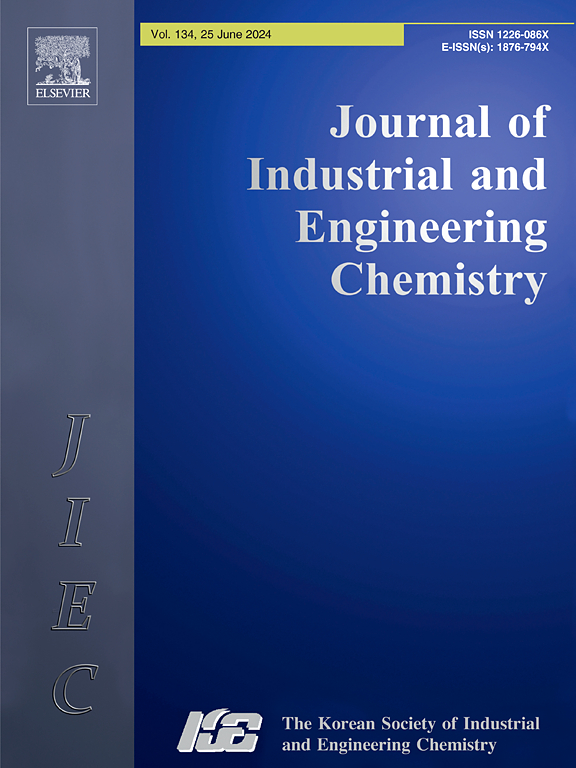Electrospun PAN membrane encapsulated in PEO as a polymer electrolyte for lithium metal batteries
IF 5.9
3区 工程技术
Q1 CHEMISTRY, MULTIDISCIPLINARY
Journal of Industrial and Engineering Chemistry
Pub Date : 2024-12-03
DOI:10.1016/j.jiec.2024.11.054
引用次数: 0
Abstract
The novel two-step fabrication method of polymer electrolyte membrane was proposed. In the first step, the polyacrylonitrile nano fibrous membrane was prepared with the help of electrospinning. In the second step, the polyethylene oxide solution was prepared along with lithium salt and plasticizers. The solution was poured on the electrospun polyacrylonitrile to get polymer electrolyte membrane in the form of PAN membrane encapsulated in PEO. The polymer electrolyte membrane was boosted by the liquid LiPF6 before assembled in the lithium metal batteries. The polymer electrolyte membrane was compared with the commercial Celgard separator when assembled in coin cell for the application of lithium metal batteries. The polymer electrolyte membrane outperformed and exhibited a good ultimate tensile strength of 20 MPa and the better thermal stability of 97 % at 305 °C. Moreover, the polymer electrolyte membrane also exhibited excellent ionic conductivity of 1.2 mS cm−1, good lithium-ion transference number of 0.57 and uniform lithium plating/stripping cycles for up to 500 cycles without internal short circuiting. The polymer electrolyte membrane represented outstanding rate capability and exhibited the good discharge capacity of 141 mA h g−1 after 100 cycles at 0.5 C rate.
电纺丝聚丙烯腈膜包封在聚氧乙烯中作为锂金属电池的聚合物电解质
提出了一种新的两步法制备聚合物电解质膜的方法。第一步采用静电纺丝法制备聚丙烯腈纳米纤维膜。第二步,将聚氧乙烯溶液与锂盐和增塑剂一起制备。将溶液倒置在静电纺聚丙烯腈上,得到包覆PEO的聚丙烯腈膜形式的聚合物电解质膜。聚合物电解质膜在组装到锂金属电池中之前,用液态LiPF6进行升压。将聚合物电解质膜与商用Celgard隔膜组装在锂金属电池的纽扣电池中进行了比较。该聚合物电解质膜在305℃时的抗拉强度为20 MPa,热稳定性为97%。此外,聚合物电解质膜还具有优异的离子电导率(1.2 mS cm−1),良好的锂离子转移数(0.57)和均匀的锂电镀/剥离循环,可达500次,无内部短路。聚合物电解质膜表现出优异的倍率性能,在0.5 C倍率下循环100次后具有141 mA h g−1的良好放电容量。
本文章由计算机程序翻译,如有差异,请以英文原文为准。
求助全文
约1分钟内获得全文
求助全文
来源期刊
CiteScore
10.40
自引率
6.60%
发文量
639
审稿时长
29 days
期刊介绍:
Journal of Industrial and Engineering Chemistry is published monthly in English by the Korean Society of Industrial and Engineering Chemistry. JIEC brings together multidisciplinary interests in one journal and is to disseminate information on all aspects of research and development in industrial and engineering chemistry. Contributions in the form of research articles, short communications, notes and reviews are considered for publication. The editors welcome original contributions that have not been and are not to be published elsewhere. Instruction to authors and a manuscript submissions form are printed at the end of each issue. Bulk reprints of individual articles can be ordered. This publication is partially supported by Korea Research Foundation and the Korean Federation of Science and Technology Societies.

 求助内容:
求助内容: 应助结果提醒方式:
应助结果提醒方式:


